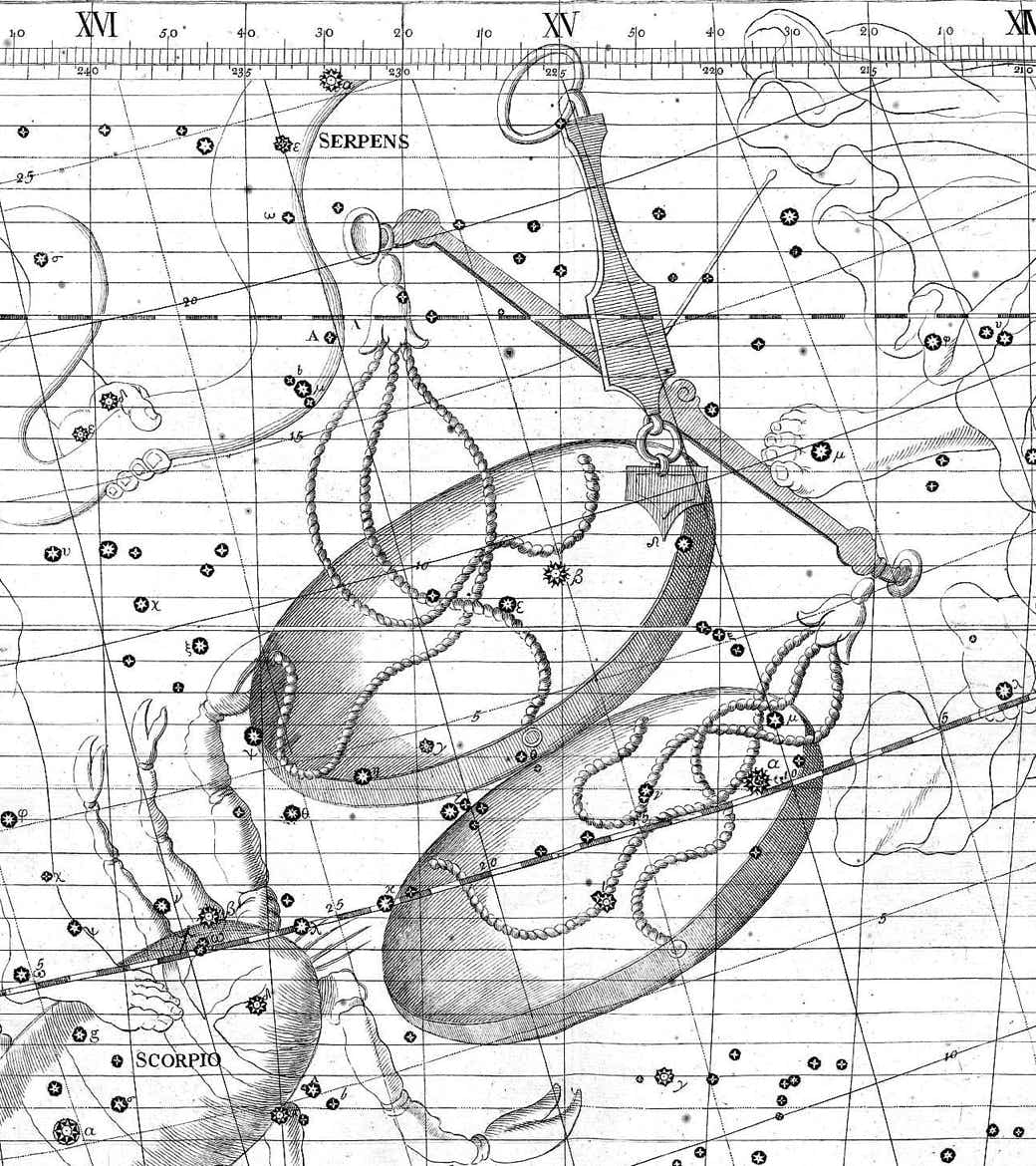
Genitive: Librae
Abbreviation: Lib
Size ranking: 29th
Origin: One of the 48 Greek constellations listed by Ptolemy in the Almagest
Greek name: Χηλαί (Chelae)
In ancient Greek times, the area of sky we know as Libra was occupied by the claws of the scorpion, Scorpius. Aratus and Eratosthenes, among others, called this area Χηλαί (Chelae), literally meaning ‘claws’, an identification that lives on in the names of the individual stars of Libra (see below). As things have worked out, Libra is now a slightly larger constellation than Scorpius, but is much less conspicuous.
The identification of this area with a balance became established in the first century BC among the Romans, although exactly when it was introduced and by whom has been lost in the mists of history. Ptolemy in the Almagest, written around AD 150, continued to refer to this constellation as the Claws, preferring to follow Greek tradition even though it was by then being superseded – for example, Libra was shown as a pair of scales on the celestial globe held by the Farnese Atlas, a Roman statue produced about the same time that the Almagest was being written. The Arabs of al-Ṣūfī’s day, eight centuries after Ptolemy, knew it both as al-Zubānayān, the claws, and al-Mīzān, the balance, maintaining the dual identity.
The balance pans of Libra, depicted in the Atlas Coelestis of John Flamsteed (1729),
with Scorpius to lower left and the feet of Virgo at the right.
Libra is the only constellation of the zodiac to represent an inanimate object; the other 11 zodiacal constellations represent animals or mythological characters. Once the identification of Libra with a pair of scales became established it was natural to divorce it entirely from Scorpius and to associate it instead with the other flanking zodiacal figure, Virgo, who was identified with Dike or Astraeia, goddess of justice. Libra thus became the scales of justice held aloft by the goddess – although, in the sky, they were positioned at her feet.
First point of Libra
To the Romans, Libra was a favoured constellation. The Moon was said to have been in Libra when Rome was founded. ‘Italy belongs to the Balance, her rightful sign. Beneath it Rome and her sovereignty of the world were founded’, said the Roman writer Manilius in the first century AD. He described Libra as ‘the sign in which the seasons are balanced, and the hours of night and day match each other’.
This is a hint that the Romans visualized Libra as a balance because the Sun lay within it at the autumn equinox, when day and night are equal. Manilius was, though, speaking of the astrological sign rather than the astronomical constellation: by Roman times the autumnal equinox no longer lay within the constellation but because of the effect of precession had moved into neighbouring Virgo, where it still lies. It crossed the modern constellation boundary from Libra into Virgo around 730 BC. Even so, it is still often referred to as the ‘first point of Libra’. It continues to move inexorably due to precession, and will eventually reach Leo in AD 2439.
In fact, the idea of a balance in this area goes back much further than the Romans. The Babylonians knew this area as ZIB.BA.AN.NA, the balance of heaven, around 1,000 years BC, when the autumnal equinox did lie among its stars. Hence it seems that the Romans revived a constellation that existed even before Greek times.
Stars of Libra
Alpha Librae, magnitude 2.7, is called Zubenelgenubi from the Arabic al-zubānā al-janūbī meaning ‘the southern claw’, a reminder of the Greek identification of this constellation with the claws of the scorpion. Beta Librae, slightly brighter than Alpha at magnitude 2.6, is Zubeneschamali, from the Arabic al-zubānā al-shamālī, ‘the northern claw’.
Ptolemy listed nine ‘unformed’ stars outside the main figure of Libra. Eight of these have since been incorporated into the constellation, while the ninth has been transferred to Scorpius and is now known as Xi Scorpii.
Chinese associations
In the Chinese sky, the square formed by Alpha, Iota, Gamma, and Beta Librae was Di, a palace for the Emperor to stay the night with his wife and two concubines. Di was also the name given to the third Chinese lunar mansion. In this context the name is usually translated as ‘root’, which is said to stem from the constellation’s appearance in the morning sky in early October when the ground dried up and roots became visible. Di is also visualized as either the paw or the chest of the Blue Dragon.
Theta and 48 Librae were part of a line of four stars leading into northern Scorpius that formed Xixian, one wall of an area used for investigating and penalizing dishonest traders in the celestial market nearby; the other wall, Dongxian, was in Ophiuchus. In southern Libra were a couple of Chinese constellations forming part of a cavalry camp spread over a large area south of the ecliptic. Zhenche, consisting of a triangle of stars (probably Sigma Librae and two to the south in Lupus), was a formation of battle chariots, while Tianfu (probably Upsilon and Tau Librae) was a convenient pile of spare spokes for mending broken wheels.
A star in Libra on or close to the ecliptic, near the border with Scorpius, was known as Ri, the Sun star; it lies on the opposite side of the sky from the Moon star, Yue, in Taurus, in recognition that the Sun lies opposite the full Moon in the sky. The identification of Riis uncertain; Kappa Librae seems most likely, although some sources identify it as either 1 or 2 Scorpii.
Even more disputed than Ri is the position of Kangchi, a lake with boats, symbolizing travellers arriving or departing by water. Sun and Kistemaker argue that Kangchi originally consisted of the stars 11, 16, and Delta Librae plus three more in Virgo. At later times, though, it lay farther north, either straddling the border between Virgo and Boötes, or wholly in Boötes.
© Ian Ridpath. All rights reserved



